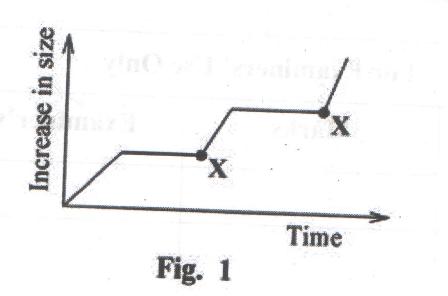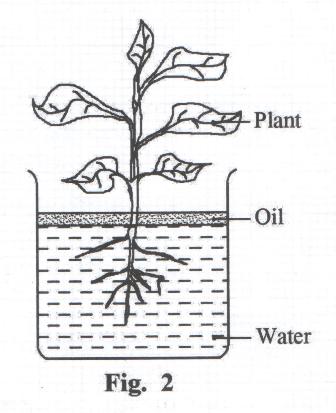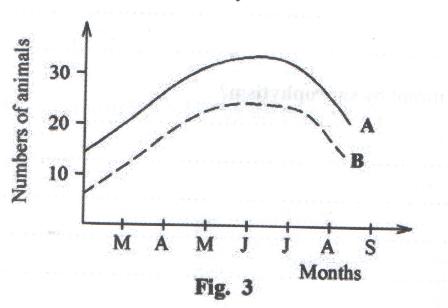- Figure 1 is a graph illustrating the growth pattern of an insect.

What process occurs at points marked X?
A. Moulting
B. Pupa formation
C. Larva formation
D. Constant growth- Which one of the following fins prevent rolling in fish?
A. Pectoral and pelvic fins
B. Dorsal and ventral fins
C. Caudal and ventral fins
D. Pectoral and caudal fins - Which one of the following os completely reabsorbed from the kidney tubules during urine formation?
A. Water
B. Glucose
C. Urea
D. Plasma proteins - Nitrogen in animal tissues is returned to the atmosphere by
A. respiration
B. defecation
C. bacterial action
D. urination - Which one of the following is a set of nutrients which are final products of digestion in humans?
A. Fats and maltose
B. Amino acids and fatty acids
C. Lactose and glycerol
D. Sucrose and oils - Plants which bear both pistillate and staminate flowers are called
A. hermaphrodite plants
B. dioecious plants
C. monoecious plants
D. bisexual plants - The back flow of oxygenated blood into the left ventricle is prevented by the
A. biscupid valve
B. septum between the two sides of the heart
C. semilunar valves
D. tricuspid valve - A housefly and a tick belong to the same phylum of arthropoda because they both have
A. two body divisions
B. jointed limbs
C. three pairs of legs
D. two pairs of antennae - What changes would occur in the eyes of a person who person moves from a dark room to a lit room?
A. The lens becomes thicker.
B. The suspensory ligaments contract.
C. The pupils narrow
D. The ciliary muscles relax - The total number of teeth in an animal having a dental formula of

- When the tip of a maize coleoptiles is covered with an aluminum foil and then illuminated on one side, it grows straight because
A. the foil kills the hormones in the coleoptiles
B. the tip does not receive the light stimulus
C. hormones in the coleoptiles move to the zone of elongation
D. the foil activates the hormones in the coleoptiles - The following is a food chain an aquatic habitat.

- Which one of the following is not an advantage of vegetative reproduction in plants?
A. Multiplication to produce new plants is fast
B. Desirable characteristics are maintained in the offspring.
C. Vegetatively reproducing plants are more resistant to disease
D. Vegetatively reproducing plants are more resistant to disease. - A vertebra with a long neural spine, short transverse processes and a small neural arch is called
A. thoracic
B. lumbar
C. cervical
D. caudal - Which one of the following is a characteristic of insect pollinated flowers?
- Produce large quantities of pollen grains
- Are small and dull coloured.
- Have large feathery stigmas
- Their anthers are firmly attached.
17. A person of blood group A can safely receive blood from a person of blood group
- B and AB
- A and O
- A only
- AB only
18. Fungi are not classified as plants because they
- do not have proper roots
- lacks vascular tissue
- lack chlorophyll
- have rigid cell walls
19. The movement of maggots to dark areas when exposed to light is an example of
- phototaxis
- reflex action
- phototropism
- conditioned reflex
20. When a red flowered plant is crossed with a white flowered plant, the offspring are pink flowered plants. What would be the proportion of the red flowered plants among the offspring if two pink plants were crossed?
21.The structure that connects two bones together is the
A. cartilage
B. muscle
C. ligament
D. tendon
22. Which one of the following would be a characteristic of a poorly adapted parasite?
A. Employing vectors
B. Inflicting severe harm to the host
C. having dormant states in its life cycle
D. Inflicting mild harm to the host.
23. 10g of a soil sample was heated at 110oC to a constant mass of 8g. What was the percentage of water in the soil sample
A. 20%
B. 8%
C. 25%
D. 80%
24. The importance of division of lungs into alveoli is to
A. allow more blood pass through the lungs
B. increase the time that air is in the lungs
C. increase the amount of gases exchanged in the lungs
D. increase the volume of air taken into the lungs
25. Which one of the following does not occur when Antidiuretic hormone is released into the blood?
A. Re-absorption of more water from the kidney tubules
B. Production of little urine
C. Production of concentrated urine
D. Production of dilute urine.
26.The advantage of cross pollination in flowering plants is that it
A. eliminates overcrowding
B. creates variation among offspring
C. forms many offspring
D. forms resistant varieties
27.Which one of the following describes a sequence of communities that develop in an area?
A. Competition
B. Immigration
C. Colonization
D. Succession
28.Which one of the following processes would be a sign in the human female if conception failed?
A. Ovulation
B. Menstruation
C. Fertilization
D. Implantation
29.Which one of the following is not a correct difference between the lymphatic system and blood circulatory system in humans?
Lymphatic System Blood circulatory system
A. No specialized pump Has specialized pump
B. Lacks red blood cells Has red blood cells
C. Flow is in one direction Flow is in two directions
D. Lacks dissolved foods Has dissolved foods
30.A dense network of capillaries in the ileum serves to
A. increase the surface area for absorption of food.
B. reduce the distance across which dissolved food moves
C. increase the time food spends in the ileum.
D. increase the rate of diffusion of food.
31. A plant leaf to be tested for starch is first dipped in hot water in order to
A. dissolve the starch present.
B. remove the chrophyll
C. burst the starch granules
D. harden the leaf
32. Figure 2 shows a set up used in an investigation on water loss and uptake, in a green plant
The setup was left in the open and the mass of the plant together with the beaker were recorded every 2 hours for 14hours. The results are shown in Table 1. Use the information to answer the questions that follow
| Time | Mass of plant and beaker (g) |
| 8.00am | 365 |
| 10.00am | 363 |
| 12.00 noon | 358 |
| 2.00pm | 353 |
| 4.00pm | 347 |
| 6.00pm | 344 |
| 8.00pm | 342 |
| 10.00pm | 341 |
a) Why was oil used in the experiment?
b) Plot on a graph paper to represent the information in Table 1.
c) From the graph, determine what the mass of the plant was, at 1.00pm.
d) Calculate the volume of water lost by the plant during the period of the experiment.
e) i) Using your graph, state the time with the highest rate of transpiration. Give a reason for your answer.
ii) Give two reasons why the time in (e) (i) had the highest rate of transpiration.
f) Suggest three ways that this plant may reduce water loss
33. a) What is meant by Saprophytism?
b) Outline three differences between saprophytic feeding and the feeding in humans.
c) Explain four ways in which saprophytes are economically important in nature.
34. The graph in figure 3 shows changes in population of prey and predator animals A and B with time, in an ecosystem.
35. a) Which curve represents the
i) prey population?
ii) predator population?
b) Give reasons for your answer in (a)
c) Explain why the two curves are similar in shape
d) Using the information in figure 3, draw and label part of a pyramid of numbers to show the relationship between the predator and prey in their ecosystem
36 a) Explain the role of each of the conditions necessary for germination
b) Explain why germination may not occur in some seeds when the necessary conditions are available.
c) Outline the importance of a seed remaining dormant during favorable conditions for germination.
37. a) Differentiate between continuous and discontinuous variation, giving an example of each, in humans.
b)Distinguish between incomplete dominance and co-dominance in heredity.
c)A man of blood group A married a woman of blood group B and they produced a child of blood group O among others. What were the genotypes of the parents and their offspring? (Show your working).
38. a) How is a mosquito adapted for transmission of the malaria parasite?
b)How can the spread of malaria be controlled in homes?
39.a) Outline the adaptations of the following structures of a plant leaf to their functions.
i) Cuticle
ii) Pallisade mesophyll layer
iii) Spongy mesophyll layer
b) Describe the modifications of leaves on plants growing in hot areas
